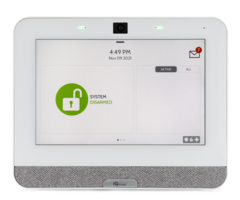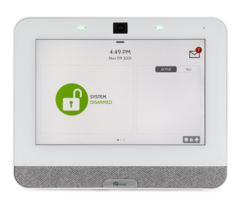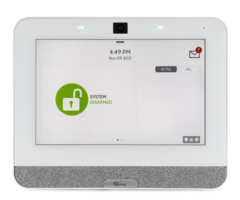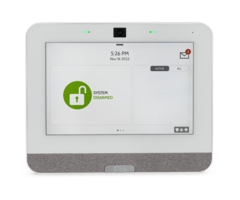Qolsys IQ Panel 4: Cellular Monitoring
Related Products






Description
In this video, Dylan from Alarm Grid discusses how to retrieve the IMEI number of the Qolsys IQ Panel 4 so that you can set your ...
Transcript
[AUDIO LOGO] Hey, DIYers. Dylan here, with Alarm Grid. Today, we're going to go over the cellular monitoring setup for an IQ 4 panel. So the IQ 4 panel has a built-in cellular communicator, which is the required path for this to be set up for monitoring and to be registered with alarm.com. This system has an IMEI number that your alarm company will need to register the system. And there's also an optional Wi-Fi option as well already built into the system as well. So that communicator, you don't have to buy anything separate to install it. Again, it's already in the system. So the Wi-Fi path is not necessary for this to be set up for monitoring, but there are a lot of pluses to it. The main plus is that if you want to do over-the-air firmware updates, which can be accessed through the panel or pushed down from your alarm company, this will need to be connected to the Wi-Fi connection for that to push successfully. Another cool feature is that when the system sends out alarm signals, it's going to use both the cellular and the Wi-Fi paths to send out that signal. And whichever path gets to alarm.com first is what registers and then contacts the monitoring center, if this is set up with a monitoring center as well. Usually, the Wi-Fi connection is quicker. The cellular is more reliable. But again, both are sent out at the same exact time. And whichever is quicker is what's going to reach alarm.com first. OK. So for the cellular monitoring, like I mentioned, you're going to need to get the IMEI number from the system and provide that to your monitoring company. So to get that, you'll press on the top gray bar, go into Settings, access Advanced Settings. Enter user code. We're going to enter the installer code, which is still 1111. That's the default code. At the top here, you'll see About, Cellular. And then IMEI number is right there. So that's what we're going to give to the monitoring company so they can connect this with alarm.com. And then you do also have the option to connect to Wi-Fi. This is good because the Wi-Fi can act as a optional communication path. The cellular will always try to send out signal. But if you have this connected to Wi-Fi as well, it's going to also send out that signal at the same time. The Wi-Fi can connect to a 2.4 or 5-gigahert network. It's usually more quick in sending out the signal than cellular, but the cellular is more reliable. So when you have both enabled, either option is going to try to send out the signal. And then whichever gets to the alarm.com service first is the one that will win. So to connect to Wi-Fi, you'll also be in this menu here, you'll go to Wi-Fi. Make sure you have this little check mark here. That's going to activate the Wi-Fi. We're already connected. But essentially, when you press on the Wi-Fi option, you'll enter in your password, and then Save, and then it'll connect. Another thing about Wi-Fi is that if you want to do firmware updates for this, Wi-Fi is required for firmware updates to be pushed from alarm.com to the actual panel. And now, another way to get the IMEI number if you don't have this already installed and you're not going through the panel programming. If you look at the back of the panel here, we have the desk mount. So it's a little bit hidden. But this bottom barcode right here, that's going to have the IMEI number. So if you haven't already installed the panel or if it's not powered on, you can just look at the back of the system, and you'll see the IMEI number there. And a good way to test that both options are secure and functioning is we'll go back to the gray bar. Oh, there we go, back into Settings. Then we will see in Advanced Settings. Enter user code. Again, we're going to use the installer, 1111. We'll see system tests. And then we can run a Wi-Fi test. OK. Wi-Fi result passed. And then we can also run a cellular test. And there we go. So information passed, connected. Because this is already connected with alarm.com. And we have the IMEI number showing there and the cell signal strength showing as well. So we know that both the Wi-Fi and the cellular paths are connected. They are functioning. So when we have this set up for monitoring, if the alarm goes off, as I mentioned, both signals will be sent out at the same time. And whichever signal is quicker is what's going to reach alarm.com first, and then also be sent out to the monitoring station, if you have this set up for live monitoring as well. OK. So that is cellular monitoring for the IQ 4 panel. Again, you're going to need to provide that IMEI number on the back of the panel or go through the menu options in the system. That number is needed for your alarm company to register this and connect it to alarm.com. And then you can again set up the Wi-Fi option, which is not necessary. Again, it's optional. But you get that added security of both the paths sending out the signal at the same time. If you did enjoy the video, please like and subscribe and hit the bell icon on our channel to be notified about any future videos we release. If you had any questions for us, feel free to reach out. Our phone number is 888-818-7728. We have an email. Our email address is support@alarmgrid.com. Also, you can go to our website, which is www.alarmgrid.com. And we have a live chat option there as well. So either way, feel free to reach out, and we'll be happy to assist you with any questions. Again, my name is Dylan from Alarm Grid. And hope you enjoyed the video.
- Uploaded
